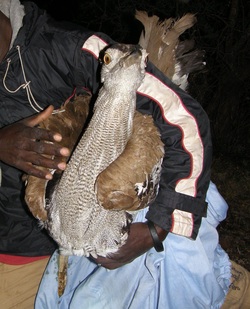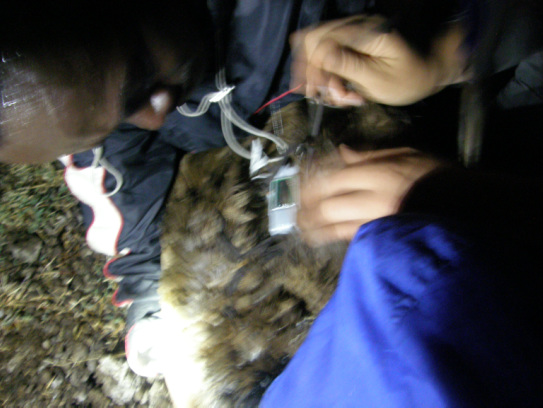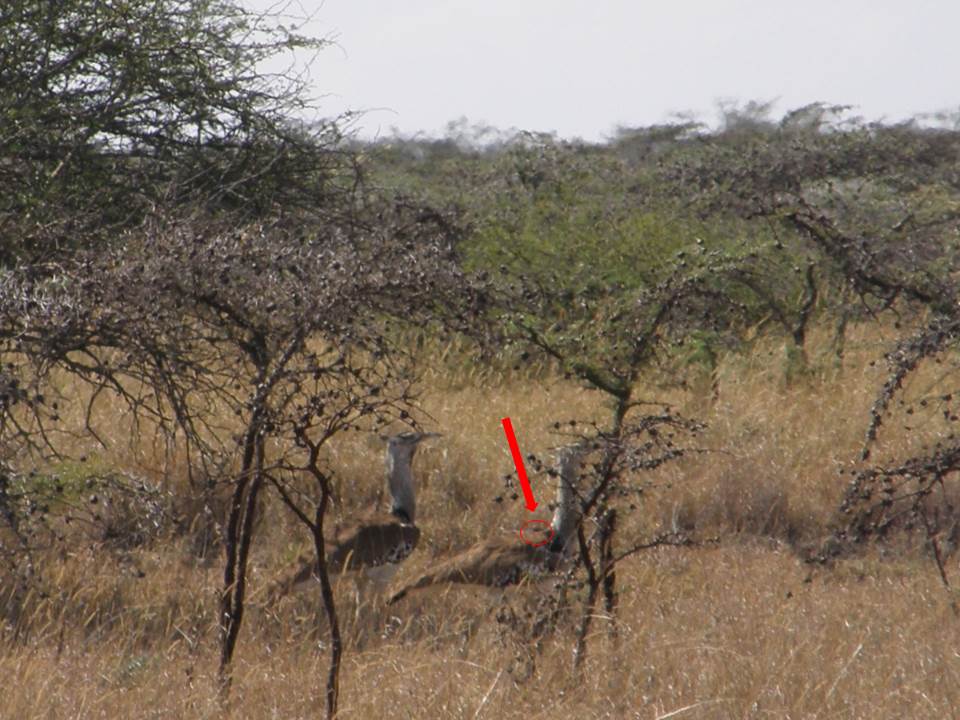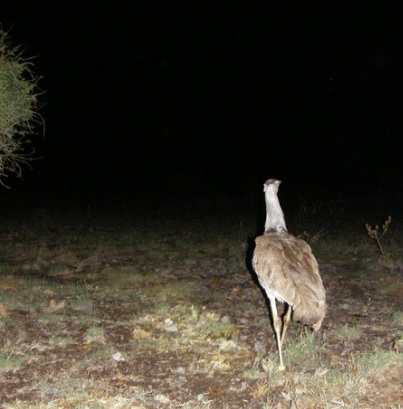|
-- Katherine Mertes, PhD Candidate Guest blog post from the Jetz Lab at Yale  Understanding how animals respond to different environmental conditions is an important step in learning why a species occurs where it does. Preference for certain conditions, and aversion toward others, can explain a species’ global range – and, on a more local scale, why a species might be found only in a few specific places within its range. In order to explore such environmental preferences and distribution dynamics for East African birds, we are attaching GPS tags to multiple species. Most recently, we captured and tagged a kori bustard, one of the largest flying birds in Africa. Capturing a kori begins with conducting surveys across Mpala to identify areas where the species can consistently be found – and where Safaricom signal is strong enough to support the GSM capabilities of the sophisticated tags obtained through collaborators at the University of Konstanz, Germany. After establishing suitable areas, the capture process works like this: spot a kori during the relatively cooler morning and evening periods, as the species is particularly sensitive to heat stress. Determine the direction the kori is headed, then rush of it ahead to hang a monofilament net 3 meters tall and 50 meters long from natural vegetation, oriented perpendicular to the sun (to reduce visibility), while keeping one pair of eyes on the bird to detect any sudden changes in direction. Once the net is securely – and, hopefully, invisibly – strung from acacias, circle back and use the vehicle to carefully, steadily, slowly herd the bird into the net. If all goes smoothly, the kori unwittingly walks into the net, becoming entangled just long enough for us to emerge from the vehicle, secure the bird in a loose yet firm grip, and place a dark hood over its head to induce calm during handling. In mid-October all did go smoothly for our field team, and we successfully attached a GSM/GPS tag to an adult male kori bustard. Over the next year, precise GPS locations collected every 5-20 minutes will enable us to learn which environmental conditions these birds prefers, and just how far they will travel to track these preferred conditions. When analyzed with movement data from other tagged species at Mpala – such as red-billed and Von der Decken’s hornbills – we hope to be several steps closer to solving fundamental questions of species distribution dynamics.
40 Comments
1/17/2023 01:22:23 am
i read a lot of stuff and i found that the way of writing to clearifing that exactly want to say was very good so i am impressed and ilike to come again in future..
Reply
2/17/2023 02:20:23 pm
It is imperative that we read blog post very carefully. I am already done it and find that this post is really amazing.
Reply
3/26/2023 06:14:12 am
AZCB top Real Estate company in Abu Dhabi, UAE. Buy and Rent villas, apartments, offices best prices with Al Zaeem Commercial Brokers
Reply
8/1/2023 05:54:28 am
Looking to earn more rental income from your vacation home? Look no further than <a href="https://voguevacationhomes.com/">Holiday Homes Dubai</a>. Our expert team of vacation home management professionals can help you increase your rental income by up to 30% and more.
Reply
8/1/2023 06:10:30 am
We at <a href="https://beyourcoupons.com/">Beyourcoupons.com</a> provide a fantastic collection of noteworthy bargains on our web page.
Reply
10/9/2023 12:34:06 pm
For <a href="https://cristauae.com/tax-services">corporate tax in uae</a> Contact Crista UAE
Reply
10/17/2023 05:35:00 am
Professional Accounting Services in Dubai And Highly Skilled Top CA Firms in Dubai
Reply
June Matt
10/20/2023 01:11:12 pm
When it comes to fit out companies in Dubai Appello Interiors LLC offers a wide range of services to cater to every need.https://www.appellointeriors.com/fit-out-contractors
Reply
10/21/2023 07:00:36 am
Integrating lush greenery and vibrant foliage can transform the entire ambiance, elevating it to new heights Corporate event plant rentals offer numerous benefits, such as creating a welcoming and refreshing atmosphere that impresses attendees and boosts their overall experience
Reply
11/4/2023 05:22:58 am
Hire the top interior designers in Dubai for villas, apartments, or commercial spaces. Contemporary, Modern, or luxury interiors in UAE. Turnkey solutions. Within Budget. On-time. Call now!
Reply
11/16/2023 07:27:24 am
Offplandxb.ae is a new emerging real-estate broker that specializes in displaying properties for both investors as well as end-users.
Reply
11/27/2023 06:58:58 am
Professional Accounting Firms in Dubai And Highly Skilled Top CA Firms in Dubai
Reply
12/5/2023 05:46:46 am
Professional Accounting Firms in Dubai And Highly Skilled Top CA Firms in Dubai
Reply
1/10/2024 12:21:44 pm
Hi my friend! I want to say that this article is amazing, great written and include almost all vital infos. I would like to see extra posts like this.
Reply
2/24/2024 07:43:09 am
hop our men's leather jackets and coats. Buy real leather jackets and coats for men with custom-made to-measure options. Free shipping in USA & worldwide.
Reply
4/2/2024 01:08:28 pm
Information Process Solutions and Services (IPS USA) is a Result Driven Web Design and Digital Marketing Agency in the USA. With over 15 years of experience in website development and digital marketing, we bring a profound dedication to detail, result-driven strategies, and a unique value proposition.
Reply
4/29/2024 06:23:51 am
Directory listings and local citations contribute to 구글 상위노출 백링크, enhancing your website's visibility in local search results.
Reply
6/14/2024 05:00:07 am
Thank you for the information , visit Banyuwangi tourism at. <a href="https://amanahtrans.my.id/">Sewa mobil banyuwangi</a>
Reply
7/10/2024 05:19:39 pm
Consistently producing valuable content helps in earning 구글 상위노출 백링크 naturally.
Reply
7/23/2024 05:49:05 am
This is highly informatics, crisp and clear. I think that everything has been described in systematic manner so that reader could get maximum information and learn many things.
Reply
Leave a Reply. |
Archives
November 2019
Categories
All
|



 RSS Feed
RSS Feed
